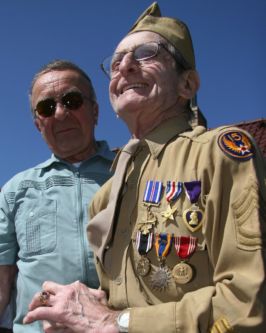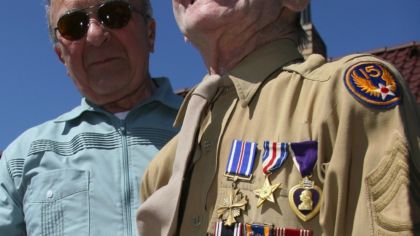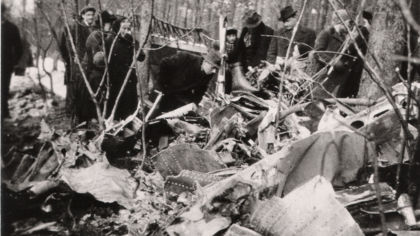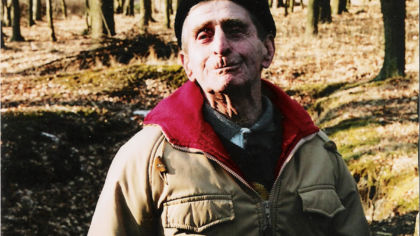Raymond A. Noury
The First of Many
Raymond A. Noury, gunner, 343rd Bomb Squadron, 98th Bombardment Group, 15th Air Force
During World War II, the Allied Air Forces and Nazi Luftwaffe engaged in countless dogfights over the Czech lands. While the initial part of the war in the skies above the Protectorate of Bohemia and Moravia was led by the British Bomber Command, starting in early 1944, more and more bomber formations from the U.S. 15th Air Force began appearing in the Czech skies, with the U.S. 8th Air Force (the “Mighty Eighth”) joining in later on.
The first encounter between the U.S. Air Force and German planes over the Protectorate took place on February 22, 1944. On that same day, the first American pilots lost their lives. By the end of the war, a tragic list of all the members of the U.S. Air Force who had died in former Czechoslovakia would be compiled, totaling several dozen soldiers (including only those casualties which could be confirmed). The identity of a number of these pilots was listed as “unknown”, while the rest were remembered by name. There was also a list of those who survived. Among the lucky ones was the diminutive gunner of an American B-24 Liberator, Sergeant Raymond A. Noury – a man who, decades later, returned to the place where he managed to escape death.
During a 15th Air Force raid on a Messerschmitt factory in the Bavarian city of Regensburg, on February 22, 1944, several attacking four-engine aircraft were shot down by the German Luftwaffe over former Czechoslovakia. Among them was Lieutenant Goddard’s bomber, which crashed near a gamekeeper’s lodge in Dubeč, close to Nepomuk. The town of Dubeč later funded and built a memorial in the place where the tragedy occurred – a memorial dedicated to ten of the crewmen, who had paid the highest price of war. The inscription commemorates not only the victims, but also the name of the only man who survived the catastrophe of Goddard’s bomber: gunner, Raymond A. Noury.
Noury became a member of the United States Air Force in 1943. That same year, he flew several missions with the U.S. 15th Air Force, which was operating out of air bases in Italy at the time. He originally wanted to fly a two-engine B-25 Mitchell but instead, due to the great need for heavy bomber crews, he became a gunner on a “Liberator”.
In December of 1943, he took part in a mission, during which he saved the life of one of his buddies by pulling him back into the bomber after he fell through a hole in the fuselage, which had been created by an attacking Messerschmitt. He was awarded the Silver Star for gallantry in action. In 2002, he received a Distinguished Flying Cross (DFC), from high-ranking military officials. At the DFC ceremony, Raymond Noury said, “This decoration does not belong just to me, but to all the men in our crew. That should not be forgotten. It was not just our airplane that didn’t make it back. All ten men who were killed – brothers, husbands, fathers, and sons – left ten families with empty chairs at their dinner tables. I think about them every day. They will forever remain in my heart.”
Noury continued in his recollections: “In January of 1944, we were assigned to the 98th Bombardment Group. In order to help out our invading units, on February 10 of that year, we carried out an attack on the coast near Anzio, with the 15th Air Force. The flak was terrible and we came back riddled with holes, like Swiss cheese. On the morning of February 22, 1944, our fateful day was upon us. Ten young human lives were lost forever. Already in the morning my heart felt tight. It started with Adams getting sick at the last minute. Adams was replaced by Technical Sergeant Hauser for the mission over Regensburg. I noticed that he was a bit nervous, but I knew what had happened to him on his last mission. A large piece of shrapnel from an anti-aircraft shell knocked the flashlight out of his hand while he tried to repair the generator, so his airplane could get back to base. After the briefing, the pilot told us, ‘Men, it’s Regensburg and we can expect the worst there.’
“While we flew to the target, one plane after another was returning – and we didn’t like that because our firepower was diminishing. We were hit very hard. There were holes everywhere, but we kept on flying. And then fighter aircraft attacked us. Carter, our ball gunner, called out that his turret had jammed up. The flak kept on coming at us, and about eight German fighters also came after us. Four of them separated from the formation and attacked. I watched the 20mm gun fire aimed right at us. Engines 3 and 4 caught on fire. I saw the wing break off the plane and it started to fall to the right. I told myself that this was the end. Suddenly I lost consciousness and regained it at about 3,000 or 4,000 feet. My parachute was full of holes, but it still opened by itself. I didn’t see the plane fall or anyone else from our crew,” said Noury, describing how Lieutenant Goddard’s aircraft was shot down.
The attacks against airplane factories were part of a huge operation called “Operation Argument”, which took place February 19-25, 1944. Both the U.S. Air Force in Europe and the RAF Bomber Command were involved in this operation – some of the most concentrated bombings of a relatively small number of targets by a large group of aircraft to that date. Their mission was singular – to destroy the factories supplying the Luftwaffe with new or repaired aircraft, so that the enemy could not pose a threat to the upcoming Normandy invasion by deploying massive formations of German fighter planes.
Shoeless and with shrapnel wounds in his leg, Ray Noury landed in the snow near the forest above the village of Chocenice. The rumble of plane engines, aircraft fire, and subsequent explosions caught the attention of every resident in the Nepomuk area. Ray was discovered by local residents and subsequently taken to the police station in Chocenice, where first aid was administered. It was there that the Gestapo from Blovice discovered him and turned him over to one of the POW camps for captured Allied airmen. Raymond Noury survived the war and returned to the United States.
In May of 2009, Ray came to Bohemia to participate in the unveiling of a new monument in Dubeč – the place that had become the grave of his ten fellow crew members. His story was revived once more and attracted dozens of observers to the quiet woods within view of Green Mountain. Among the visitors to this memorial ceremony were war veterans who can proudly bear the title of “Liberators of Pilsen”, including Erik Petersen, from the 16th Armored Division and Earl Ingram, from the Indianhead Division. George Patton Waters, the grandson of legendary General George S. Patton, was also in attendance. These men all shook hands with Ray and, in this place filled with mystery, homage was paid to the memory of the young American airmen who helped fight for the final victory over the Nazi occupying forces. For those who consider their death a message of self-sacrifice and courage to confront the enemy head-on, the encounter in Dubeč with Ray and the other war veterans was a moment never to be forgotten.
From book 500 hours to victory



